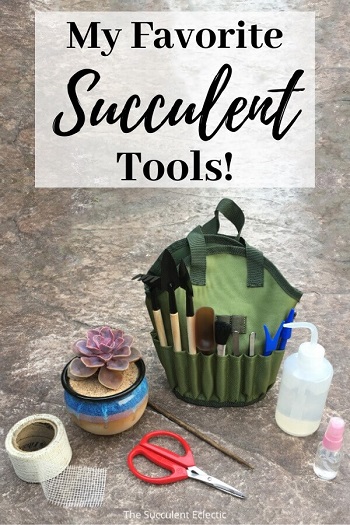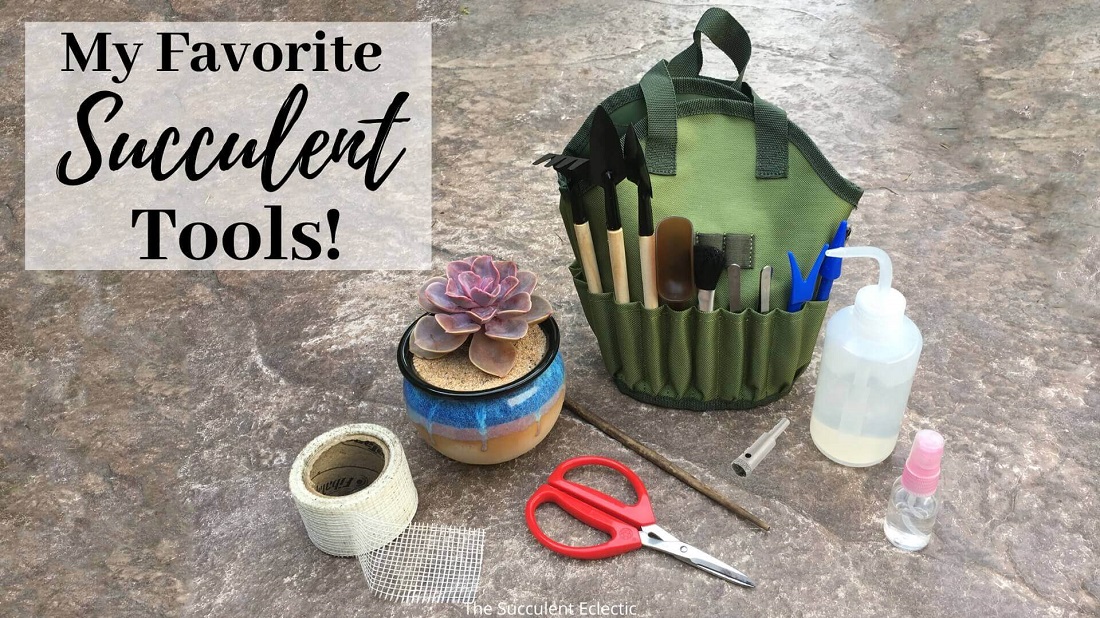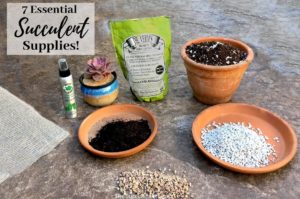Whether you’re planting succulents, propagatingPropagating (PRAH-puh-gate-ing) a plant is to grow another p... them, or caring for your succulent garden, you may be wondering what type of garden tools are best to work with. What succulent tools do you really need, are they worth it, and how do you use them, anyway? First — let me be clear. You really don’t need any of the tools I’m going to discuss. Beyond fast-draining succulent soil and a place to plant, everything else is negotiable — except the succulents! That being said, there are several tools I wouldn’t be without. You can skip straight to my recommended succulent garden tools on Amazon, or read on to learn all about those tools and how I use them!
Awesome Succulent Garden Tools & How to Use Them
In this Post We'll Cover:
{Please note, some links in this post may be affiliate links to sites that pay me a small commission if you click on the link and make a purchase. This commission is at absolutely no cost to you. I only recommend products and companies that I have worked with and truly love! ~Kat}
Succulent Garden Tools

The true essentials for planting succulents are fast-draining succulent soil and a container (unless you plant climate-hardy succulents in the ground). That’s it! All else is optional — except for succulents! Because, of course, you can scoop and dig soil with your hands, you can swipe scissors or a sharp knife from the house, you can water from an empty soda can…
However, there are a number of excellent tools available that make succulent gardening so much easier, more enjoyable, and more efficient. I use some of these tools all the time. Others, not so much. I’ll list them here and review those I use most:
- Succulent tool kit with handy carry-all bag
- Super sharp Joyce Chen snipper/scissors extraordinaire
- Drywall mesh tape
- Diamond grit hole saw drill bit
- Wooden chopstick
- Spray bottle with isopropyl alcohol
My Favorite Succulent Tool Kit
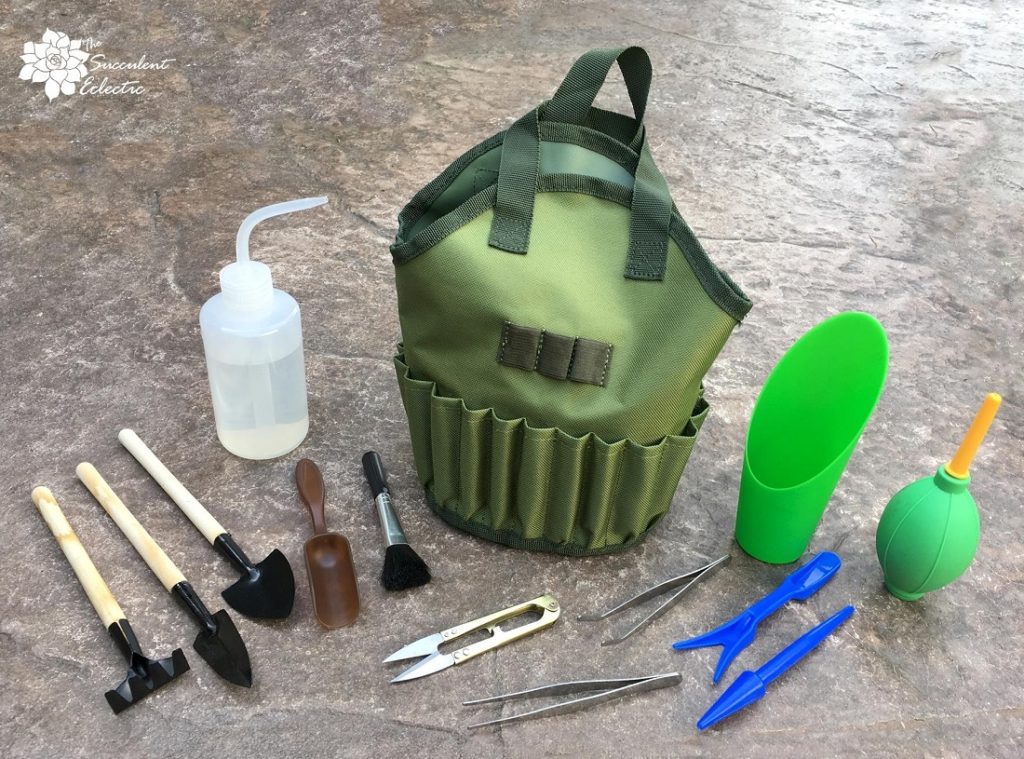
I just love this succulent tool kit! While I don’t use every tool in it, those I do use are absolutely must-haves. And above all, I love the sturdy canvas bag that holds all of the included tools and more. The pockets continue along the back of the bag with a wide pocket on each side. The central space is roomy and holds the water bottle, scoop, the rest of my tools, some top dressing, and room for more. Before I got this kit, I stashed my tools in a makeup case, but this is better. It holds more and is easier to organize. For far less than $20, I consider this a great deal.
I have never used the tiny shovel, spade, or rake, but they’re pretty darn cute. Let me tell you what is vitally necessary here:
Squeeze Water Bottle
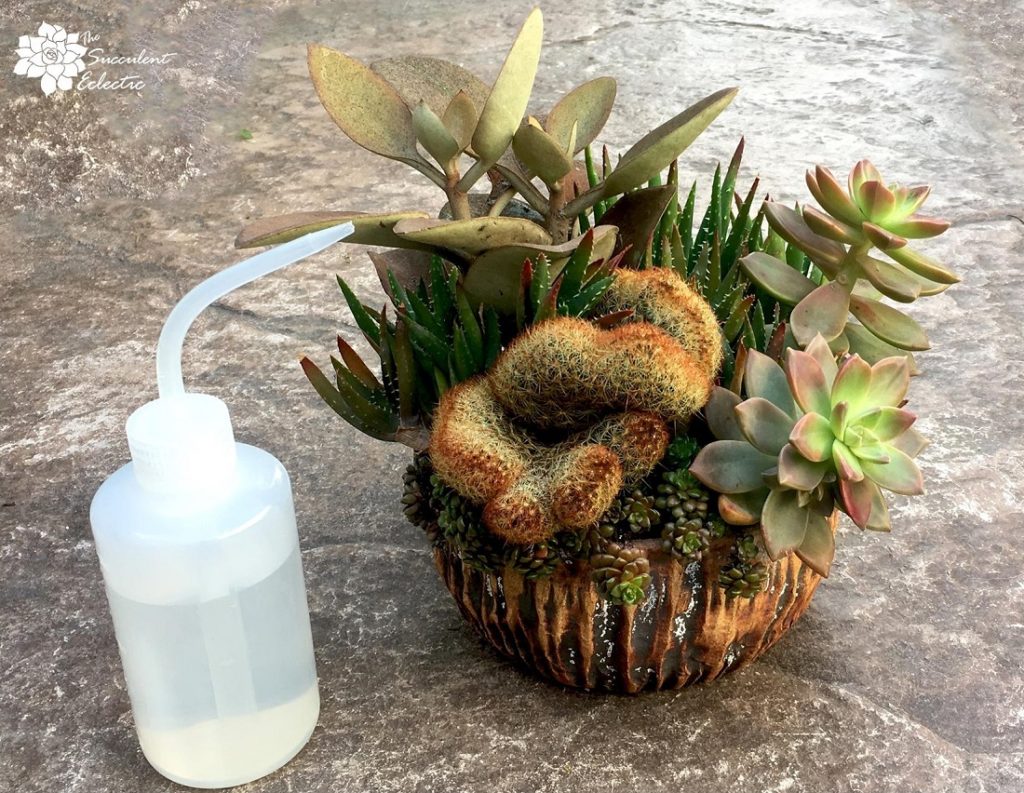
Watering succulents properly is critical for their health. The squeeze water bottle is ideal for watering close-planted succulent arrangements like this one. It lets me get the water right down among the plants to the soil line where it is needed. I do not like watering succulents from above where it can collect in the leaves. While some can handle it, others, like Echeveria Black Prince, collapse. Besides, that’s not where the water is needed. This water bottle is an absolute must-have succulent tool for my garden and me.
Small Scoop for Succulent Top Dressing
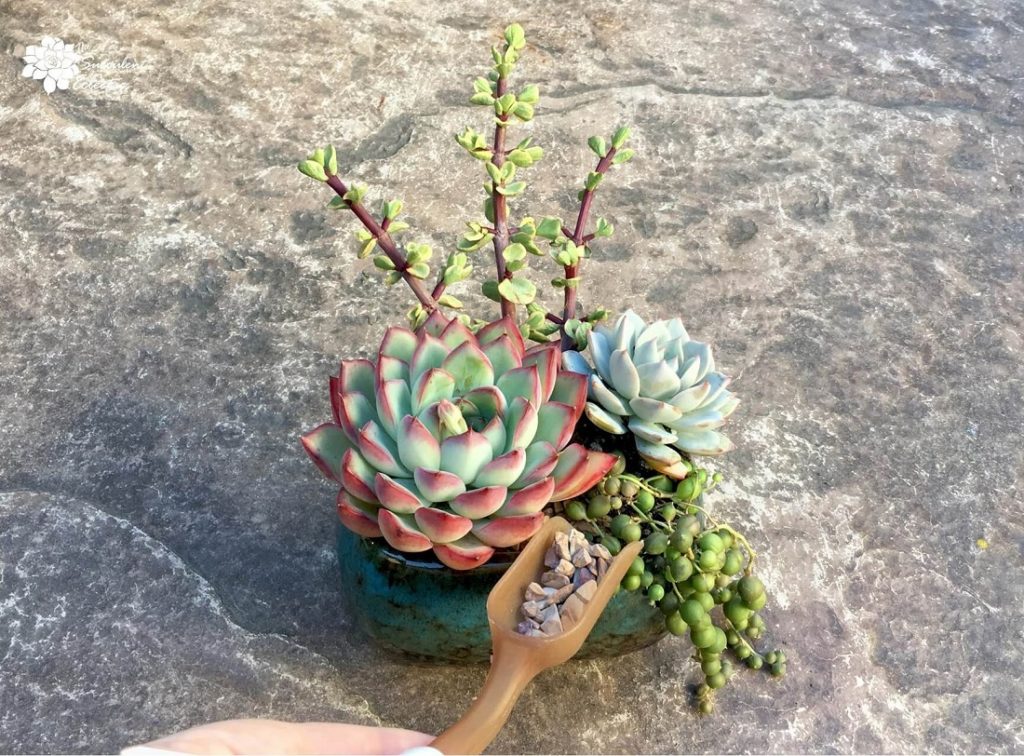
When you add top dressing to your succulents, this scoop is so handy. For a single plant in a pot, you can, of course, use your hand to scoop the pebbles, rocks, or sand into place. But in a close-planted arrangement like this, a little scoop is easier for getting the pebbles just where you want them.
Soft Bristle Brush
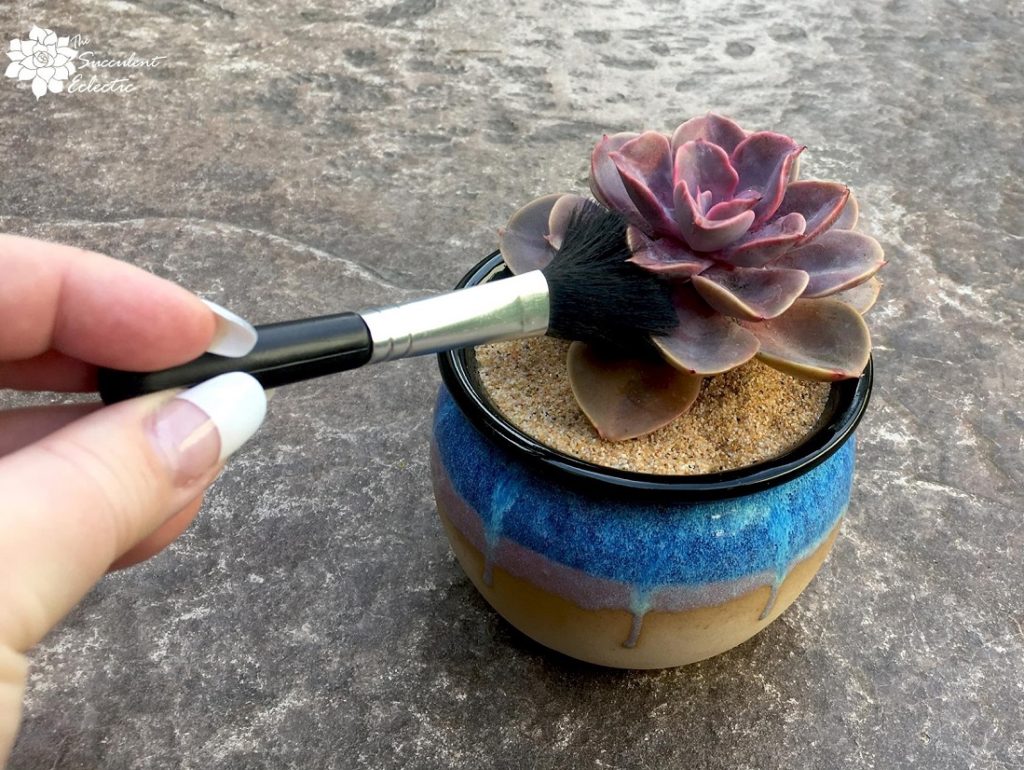
When you work with succulents, they get dust, soil particles, or pumice on their leaves. You don’t want to wipe the leaves with your finger because if it’s a variety with glaucousGlaucous (GLAH-cuss) leaves have the appearance of the whiti... leaves or epicuticular waxEpicuticular wax (Ep-i-cyoo-TI-cyoo-lar wax) is a natural, ..., you’ll remove the wax, and the plant is no longer protected, and it can look unsightly. A soft-bristle brush like a cheap makeup brush or paintbrush is perfect for whisking away any soil without disturbing the farinaFarina is a term for a very fine flour. Used with succulents... More. I always carry a brush when I review my succulents.
Tweezers for Cleaning Cactus Plants
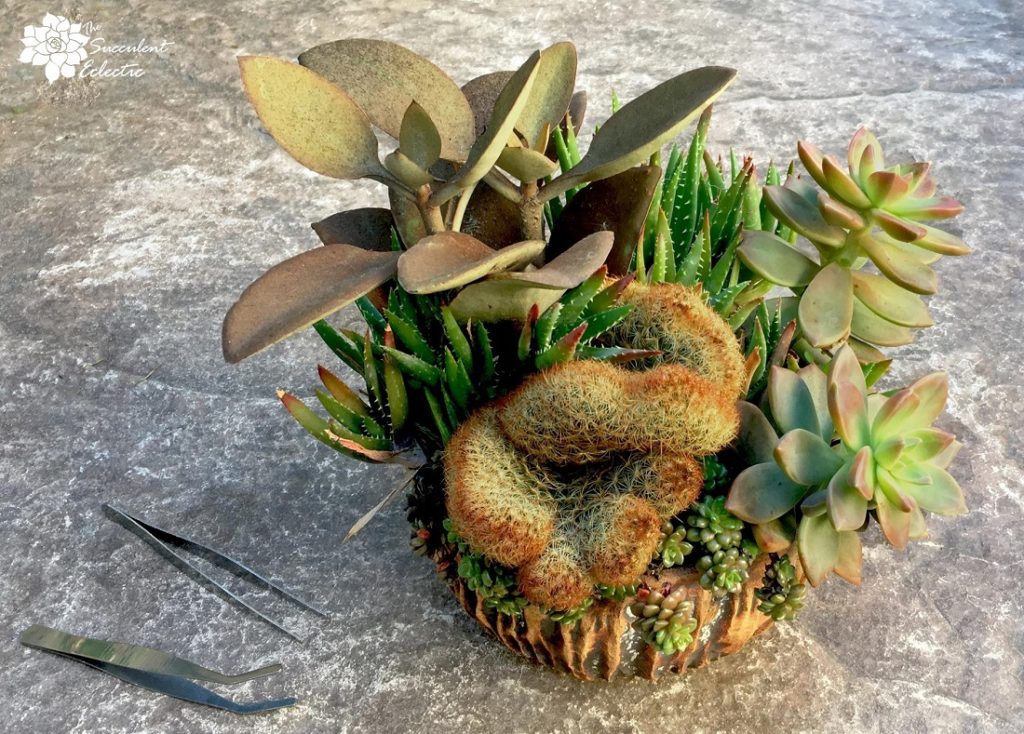
These small tweezers are such useful succulent tools. They’re perfect for picking out a weed or a spent leaf from a close-planted succulent arrangement. And when a cactus gets something caught in the quills, the tweezers are perfect for getting it loose. The brush just doesn’t work as well. They’re also handy for placing small succulents or cactus in and among other plants.
While I don’t have pictures of the rest of the succulent tools in the kit, the scoop is handy for scooping out soil or pumice. The squeeze bottle makes a puff of air that is useful for cleaning dust from cactus plants, especially in tight arrangements. The blue plastic dibbler is good quality and intended for making holes in the soil when you plant. I just use my hands. The blue fork is handy for placing cactus in a planter. I typically use the tweezers for small cactus and a roll of newspaper as a collar for larger cactus plants. The clipper is very sharp and good for the many cuttings and trimming you make along the way.
Joyce Chen Scissors for Succulents

Joyce Chen scissors are simply amazing! So strong, well-balanced, and sharp, they cut through anything! I tend to be very hard on my tools and expect them to do things they are not designed for. So, I used to go through clippers pretty quickly. Not so with these Joyce Chen scissors! These are perfect for succulent stem cuttings, root pruning, cutting drywall mesh, and all sorts of garden tasks. These are, hands down, the very best clippers/scissors I have ever used. Strangely, I am now taking better care of these excellent scissors than of the cheaper pairs I have exhausted in the past! Fair warning: once you use these — you’ll never want to be without them!
Dry Wall Mesh Tape to Cover Drainage Holes

So… about that drywall mesh tape. I know you’re wondering how drywall mesh tape could possibly make my list of favorite succulent tools. You always want to plant succulents in a container with drainage holes. But how do you keep the succulent soil from falling out of the drainage hole? While I have used broken pottery, coffee filters, paper towels, and window screen, a roll of drywall mesh tape is perfect. It’s slightly sticky on one side to hold it in place. A single roll will do hundreds of pots and fits neatly in my handy dandy succulent tool kit bag. This is a terrific solution to a common gardening issue.
Drill Your Own Drainage

While it is possible to grow succulents in a container without drainage — I do not recommend it, especially for beginners. But so many cute containers and odd finds that would make a cute succulent container don’t have a drainage hole. A diamond grit hole saw drill bit and the right technique for drilling ceramic can change any gravy boat, teacup, vase, or any other ceramic item into a succulent pot with drainage.
I purchased my first diamond grit hole saw drill bit (try saying that 3 times fast!) at Home Depot for more than double the price I just spent on Amazon for these 5 bits in graduated sizes!
Chopsticks are Handy Tools
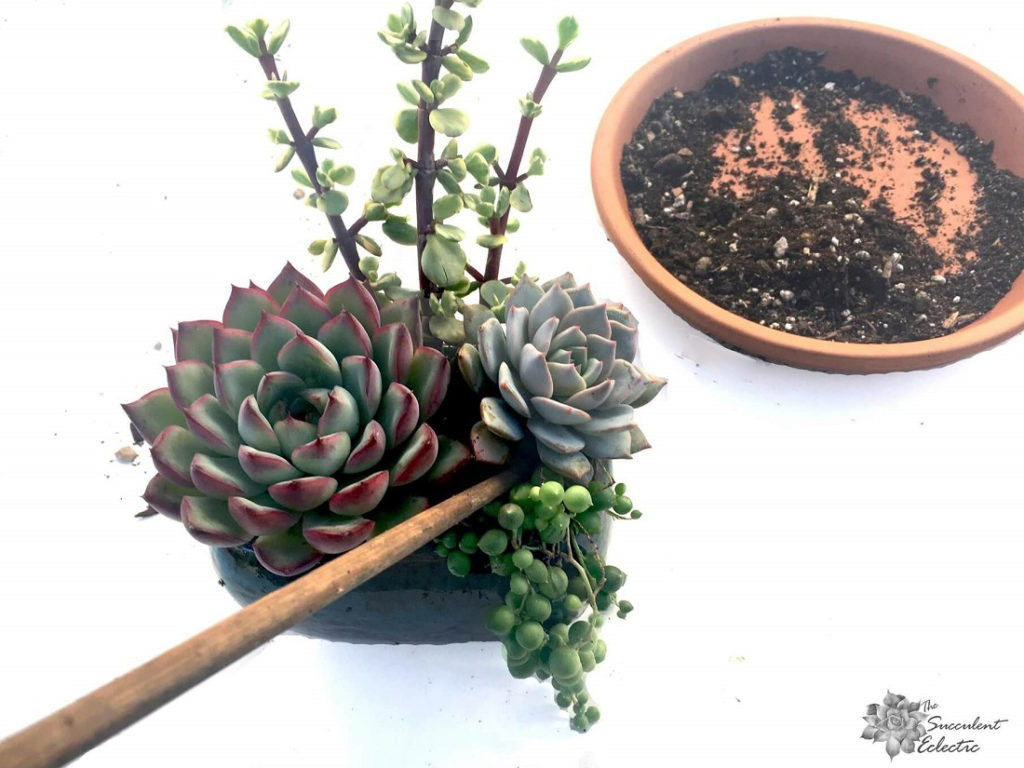
A wooden chopstick is always a handy tool for gardening with succulents or any type of plant. It’s a good way to determine if the soil deep inside a pot is still wet. Poke the chopstick into the soil. If it comes out damp or with soil particles clinging to it — skip watering for another few days. If it comes out clean and dry, it is safe to water. A chopstick is also handy for pushing a succulent’s roots into place in tight quarters and for tamping soil between plants into place.
Small Spray Bottle for Succulents

A small spray bottle filled with isopropyl alcohol is perfect for spot-treating mealybugs, whiteflies, or other succulent pests. In all honesty, I don’t use this method much at all since I started using worm castings to prevent insects on succulents. But this bottle still lives in my succulent tool kit, just in case. If you don’t use worm castings, arm yourself against the pests that want to feed on your succulents with isopropyl alcohol. Just be sure to spray your succulents out of direct sun. It is best to protect your succulents for 24 hours after spraying to prevent discoloration.
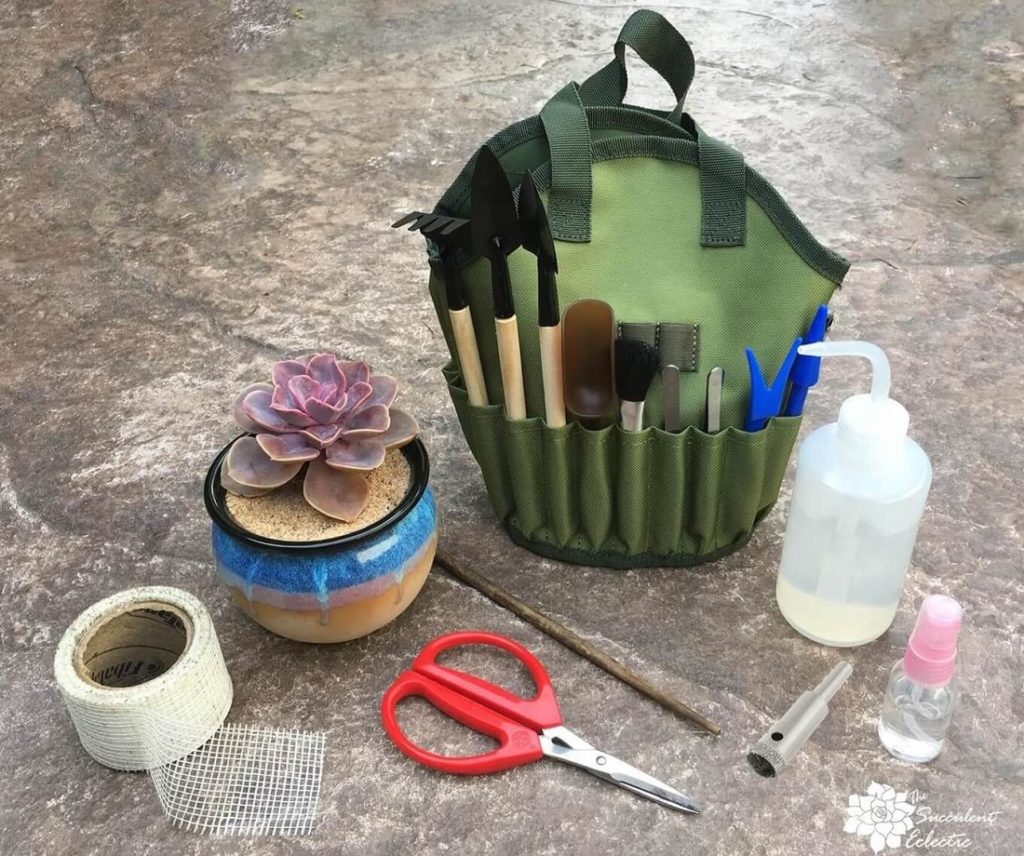
I hope you found this review of my favorite succulent tools useful. If you have any favorites I did not list, or if you have any questions — leave a comment and let me know! I’ll get right back to you!
Happy Succulent Gardening!
P.S. For more information on all things succulent, please subscribe and enjoy my FREE course, 7 Steps to Succulent Success. Thanks so much!
P.P.S. Why not join my Facebook Group for succulent lovers? We talk about succulent care, propagation, succulent identification, and design. It’s a warm and welcoming group that would love to meet you!
